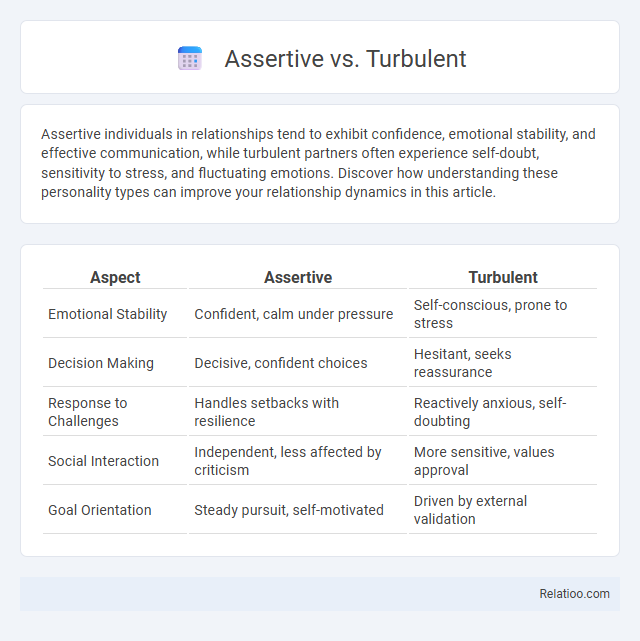Assertive individuals in relationships tend to exhibit confidence, emotional stability, and effective communication, while turbulent partners often experience self-doubt, sensitivity to stress, and fluctuating emotions. Discover how understanding these personality types can improve your relationship dynamics in this article.
Table of Comparison
| Aspect | Assertive | Turbulent |
|---|---|---|
| Emotional Stability | Confident, calm under pressure | Self-conscious, prone to stress |
| Decision Making | Decisive, confident choices | Hesitant, seeks reassurance |
| Response to Challenges | Handles setbacks with resilience | Reactively anxious, self-doubting |
| Social Interaction | Independent, less affected by criticism | More sensitive, values approval |
| Goal Orientation | Steady pursuit, self-motivated | Driven by external validation |
Understanding Assertive and Turbulent Personalities
Assertive personalities exhibit confidence, emotional stability, and a proactive approach to challenges, often maintaining calm under pressure and demonstrating resilience. Turbulent personalities tend to be sensitive to stress, experience self-doubt, and show heightened emotional responses, leading to increased self-awareness and motivation for self-improvement. Understanding the distinct emotional regulation and stress management styles of assertive and turbulent personalities is essential for improving social compatibility and effective interpersonal communication.
Key Differences Between Assertive and Turbulent Types
The key differences between Assertive and Turbulent types lie in their emotional stability and response to stress, with Assertive individuals displaying confidence and resilience while Turbulent types tend to experience heightened sensitivity and self-doubt. Assertive personalities maintain consistent motivation and handle setbacks with composure, whereas Turbulent personalities may be more prone to anxiety and self-criticism, affecting decision-making and stress management. Understanding these distinctions can improve your communication and social compatibility by tailoring interactions to emotional responses and stress tolerance.
Traits of Assertive Personality Types
Assertive personality types demonstrate high self-confidence, emotional stability, and resilience to stress, enabling them to handle social interactions with ease. These individuals exhibit clear communication, decisiveness, and a strong sense of control over their environment, which contributes to effective conflict resolution. Assertive traits promote positive social compatibility by fostering trust, openness, and mutual respect in relationships.
Traits of Turbulent Personality Types
Turbulent personality types exhibit heightened sensitivity to stress, frequent self-doubt, and a strong desire for self-improvement, distinguishing them from assertive or socially focused individuals. These traits often drive turbulent individuals to be perfectionists who are deeply responsive to feedback and highly aware of their emotional states. Their compatibility in social settings can be complex, as their emotional intensity and vulnerability may require understanding and patience from others to foster harmonious relationships.
How Assertive Individuals Handle Stress
Assertive individuals handle stress by maintaining a calm and confident demeanor, which helps them stay focused and make clear decisions under pressure. Their resilience allows them to navigate challenges without becoming overwhelmed, often using proactive problem-solving strategies. By managing stress effectively, your interactions with assertive personalities tend to be straightforward and constructive, fostering positive social compatibility.
How Turbulent Individuals Respond to Challenges
Turbulent individuals typically respond to challenges with heightened self-awareness and emotional sensitivity, often reflecting deeply on setbacks to improve their future performance. Their tendency toward perfectionism and self-doubt can drive relentless effort but may also lead to stress under pressure. Understanding your turbulent nature allows you to harness this introspection for growth while managing emotional responses constructively.
Impact on Decision-Making: Assertive vs Turbulent
Assertive individuals display confidence and decisiveness, leading to swift and firm decision-making, even under pressure. Turbulent individuals often experience higher levels of self-doubt and emotional sensitivity, which can result in more cautious and sometimes prolonged decision processes. This contrast impacts how decisions are approached, with assertive types favoring risk-taking and turbulent types prioritizing careful evaluation.
Workplace Dynamics: Assertive and Turbulent Styles
Assertive personalities in the workplace exhibit confidence and decisiveness, driving productivity and clear communication, while turbulent individuals often show heightened sensitivity to stress and a strong focus on self-improvement, which can lead to both meticulous work and occasional conflict. Social compatibility between assertive and turbulent styles influences team cohesion, as assertive members push forward goals, while turbulent members may challenge ideas for quality assurance, requiring balanced management strategies. Understanding these dynamics helps organizations foster environments where diverse emotional responses contribute to innovation and resilience.
Personal Relationships: Comparing Assertive and Turbulent Behaviors
Assertive individuals in personal relationships tend to communicate confidently and handle conflicts with calmness, promoting stability and trust. Turbulent individuals often experience emotional fluctuations and sensitivity to stress, which might lead to misunderstandings or perceived insecurity. Understanding Your partner's assertive or turbulent tendencies enhances compatibility by fostering empathy and effective emotional support.
Developing Balance Between Assertive and Turbulent Traits
Developing balance between assertive and turbulent traits enhances emotional intelligence by fostering self-confidence while maintaining sensitivity to feedback. Integrating assertiveness promotes clear communication and decisiveness, whereas embracing turbulence encourages adaptability and self-reflection. This balance improves social compatibility by allowing individuals to navigate interpersonal dynamics with both strength and empathy.

Infographic: Assertive vs Turbulent
 relatioo.com
relatioo.com